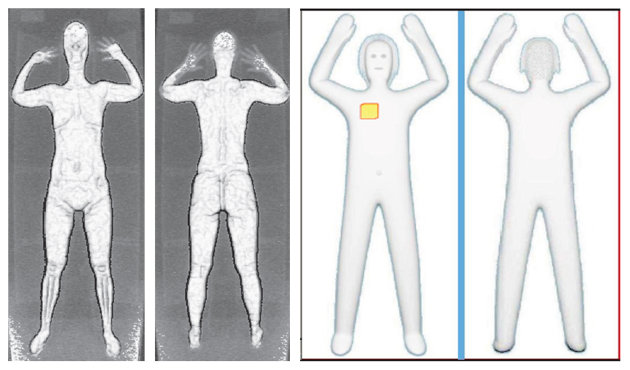The federal government is quietly removing full-body X-ray scanners from
seven major airports and replacing them with a different type of machine that
produces a cartoon-like outline instead of the naked images that have been
compared to a virtual strip search.
(AP Photo/Transportation Security Administration)
The Transportation Security Administration says it is making the switch
in technology to speed up lines at crowded airports, not to ease passenger
privacy concerns. But civil liberties groups hope the change signals that the
equipment will eventually go to the scrap heap. "Hopefully this represents
the beginning of a phase-out of the X-ray-type scanners, which are more privacy
intrusive and continue to be surrounded by health questions," said Jay
Stanley, a privacy expert at the American Civil Liberties Union. The machines
will not be retired. They are being moved to smaller airports while Congress
presses the TSA to adopt stronger privacy safeguards on all of its imaging
equipment.
In the two years since they first appeared at the nation's busiest
airports, the "backscatter" model of scanner has been the focus of
protests and lawsuits because it uses X-rays to peer beneath travelers'
clothing. The machines are being pulled out of New York's LaGuardia and Kennedy
airports, Chicago's O'Hare, Los Angeles International and Boston Logan, as well
as airports in Charlotte, N.C., and Orlando, Fla. The TSA would not comment on
whether it planned to remove machines from any other locations. Some of the
backscatter scanners have gone to airports in Mesa, Ariz., Key West, Fla., and
San Juan, Puerto Rico. The TSA is still deciding where to send others.
The switch is being made as the TSA is under political pressure.
Legislation approved in February gave the agency until June to get rid of the
X-ray scanners or upgrade them with software that produces only a generic outline
of the human form, not a blurry naked image. The agency, however, has the
authority to grant itself extensions, and the current deadline is now May 31.
So far, the upgrades have been made only to the TSA's other type of
scanner. Called millimeter-wave scanners, they resemble a large glass phone
booth and use radio frequencies instead of X-rays to detect objects concealed
beneath clothing. The scan is processed by software instead of an airport
security worker. If the software identifies a potential threat, a
mannequin-like image is presented to the operator showing yellow boxes over
areas requiring further inspection, by a pat-down for example.
Besides eliminating privacy concerns, the machine requires fewer people
to operate, takes up less space in crowded security zones and completes a scan
in less than two seconds, allowing screening lines to move faster. "It's
all done automatically to look for threats, so you don't have anybody in a back
room that has to look at the imaging," said Doug McMakin, who led the team
that developed the millimeter-wave technology at the Pacific Northwest National
Laboratory.
In a statement, officials said speed was the reason for the switch to
the millimeter-wave machines. In addition to speed and space advantages, the millimeter-wave
technology does not produce the ionizing radiation that has led to safety
concerns with the X-ray machines, which required passengers to stand between
two refrigerator-sized boxes. The TSA and other experts have said the amount of
radiation is less than what passengers get on the flight itself. A TSA
spokesman would not say whether the change was the beginning of a phase-out for
the X-ray scanners. The agency said in the statement that it was confident both
types of machine could ensure passenger safety.
The government began deploying both types to airports in 2010 after a
foiled al-Qaida plot to bomb a U.S.-bound jet using explosives that can be
missed by traditional metal detectors. The scanners can cost as much as
$170,000 each. There are currently about 800 of them at 200 U.S. airports.
About two-thirds of them are the millimeter-wave machines. The TSA has spent
nearly $8 million developing the upgraded privacy software and plans to spend
more as it works to develop software for the backscatter machines, according to
a September report by the House Homeland Security Subcommittee on
Transportation Security.
The committee's Republican chairman, Rep. Mike Rogers of Alabama, said
the TSA needs to be more forthcoming about when it will have that upgrade
"rather than simply shuffling" the machines from one airport to
another. "Travelers deserve to see a concrete timeline for implementing
privacy software on all (scanning) machines and a commitment from TSA to
sponsor an independent analysis of their potential health impact," he
said. Aviation expert Robert Poole of the Reason Foundation said it made sense
to switch to the millimeter-wave scanners at busier airports, noting that
"the faster processing time is a huge advantage." "But it still
seems like a very poor decision to still be foisting those flawed machines — or
certainly less good machines — on people in the smaller airports," he
said.
Yahoo News
Please share

No comments:
Post a Comment